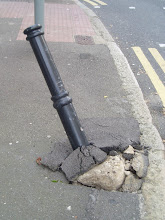As observed by humans, time consists of three distinct phases: past, present and future. Moments in time, which were once thought to be universal in the Newtonian scheme, are now understood to be relative since the discoveries of Einstein. Two paradoxes about time travel appear to make it an impossibility. The first is that if time travel were possible, why haven't we seen time travellers from a later technological age travel back to our time? The second is that if you could travel back in time, wouldn't you be able to modify the events of the past, and so change the present day?
Both paradoxes can be debunked, but first I want to tackle the present "now", to show that its component is not just "time", but "space and time". An event which I personally witnessed will be used to illustrate this, but you can easily check the data for yourself. In 1999 I travelled to Kamen Bryag in Bulgaria to see the solar eclipse as detailed by this map. A solar eclipse as viewed from the Earth is the moment when the Moon obscures the Sun, and darkness is observed during daytime. The darkness typically lasts a couple of minutes, but this will vary according to how close you can get to the centre of the eclipse, and to where and when the eclipse occurs on the Earth's surface. Kamen Bryag was on the centre line of the 1999 eclipse, and is on the Black Sea coast, so it can be located as the mostly easterly point of landfall for the eclipse on the map.
From the map you see that I would have witnessed the height of the eclipse at about 11:12:20 am on 11/08/99. Since the Sun, the Moon an myself were perfectly aligned, you might expect that the time was aligned too, but this is not the case. We know that light takes about 8 minutes and 12 seconds to reach us from the sun. This means that an observer on the sun would not witness the eclipse at Kamen Bryag until 11.20.32 am (ie the time on Earth, plus the time it takes for light to travel back to the Sun). Similarly a witness on the Moon would not see the event until 1.3 seconds after an observer on Earth.
So three objects are aligned, but witnesses at each different place note different times for the alignment to occur. If I shout "now" at the moment of the height of the eclipse, we note that there is one shout of now at each observation point, and they occur at different times. Now is both a measure of space and time.
Travelling forward in time is trivial to demonstrate. I get in my car, and and I drive to Leeds. It takes about 2 hours. I have travelled through time and space to reach Leeds. How do I travel back in time?
This article was written in 2010. Suppose I want to witness Earth in the 1970's. Simple, I travel to a place in the galaxy which is 40 light years from Earth and I build a massive telescope to witness Earth from 4 decades ago. The truth of the matter is that in that part of the galaxy which is 40 light years from Earth, it still is 1970. The "now" which is 1970 Earth is a matter of both space and time.
Another example of travelling backward in time goes like this. Take a fantastically fast space ship and send it to a place which is 1 light year from Earth. Suppose that observed from Earth it took 4 years to get there. To the occupants of the space ship, it will have taken just 3 years to reach their destination (ie 4 years observed from Earth is 3 years travel, plus 1 year for the signal to travel, saying they have arrived). The ship then returns to Earth. From Earth the return voyage takes 4 years again, a total journey time of 8 years. To the occupants of the space ship, the return journey takes 3 years, a return voyage of 6 years. In other words, the occupants of the ship will have travelled 8 years into the future on Earth, for a journey time of 6 years. The occupants of the ship will have travelled forward in time 2 years. But all motion is relative, why not regard the Earth as having travelled, and the space ship as having stayed put? In which case the Earth will have travelled back in time by 2 years.
So what of the two time travel paradoxes? The first is mundane. Time travel is actually so commonplace we are are rarely able to spot it. We don't need to invent time travel, because we have been doing it all our lives. Move through space and you will reach a different time.
The second paradox is demolished when you understand that to observe a different time, you must be so far away that you cannot change the past. To observe the 1970's I needed to be 40 light years away. To try to influence the 1970's it would take another 40 years for my signal to arrive.
A strange solicitation of grant reviewers by the NIH
11 hours ago


